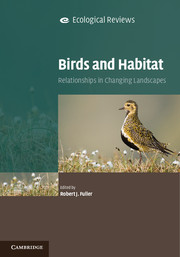Book contents
- Frontmatter
- Contents
- List of Contributors
- Preface
- Part I The complexity of patterns and processes
- Part II Case studies of habitat use and selection
- Chapter Eight Spatial variation and habitat relationships in moorland bird assemblages: a British perspective
- Chapter Nine Arctic-alpine mountain birds in northern Europe: contrasts between specialists and generalists
- Chapter Ten Bird–habitat relationships in reedswamps and fens
- Chapter Eleven Breeding waders on wet grassland: factors influencing habitat suitability
- Chapter Twelve Processes influencing bird use of estuarine mudflats and saltmarshes in western Europe
- Chapter Thirteen Avian habitat use on the non-estuarine intertidal coast
- Chapter Fourteen Temperate western European woodland as a dynamic environment for birds: a resource-based view
- Part III Wider perspectives
- Species index
- Subject index
- References
Chapter Eight - Spatial variation and habitat relationships in moorland bird assemblages: a British perspective
Published online by Cambridge University Press: 05 December 2012
- Frontmatter
- Contents
- List of Contributors
- Preface
- Part I The complexity of patterns and processes
- Part II Case studies of habitat use and selection
- Chapter Eight Spatial variation and habitat relationships in moorland bird assemblages: a British perspective
- Chapter Nine Arctic-alpine mountain birds in northern Europe: contrasts between specialists and generalists
- Chapter Ten Bird–habitat relationships in reedswamps and fens
- Chapter Eleven Breeding waders on wet grassland: factors influencing habitat suitability
- Chapter Twelve Processes influencing bird use of estuarine mudflats and saltmarshes in western Europe
- Chapter Thirteen Avian habitat use on the non-estuarine intertidal coast
- Chapter Fourteen Temperate western European woodland as a dynamic environment for birds: a resource-based view
- Part III Wider perspectives
- Species index
- Subject index
- References
Summary
Moorlands represent the largest extent of semi-natural habitat remaining in Britain. They provide habitat for some of Britain’s most spectacular and charismatic bird species, and yet may often seem vast tracts of barren, inhospitable land, devoid of life. Moorlands occur in other temperate-zone uplands (e.g. in Scandinavia and Russia), as well as in some high-altitude tropical zones (e.g. the Andean páramos) (Holden et al., 2007). Britain’s moorland bird assemblages have been extensively studied and this chapter summarises current knowledge of their regional and habitat variation.
Definitions of moorland vary, but here we use the term to mean the open habitats lying between the upper edge of enclosed farmland and the original climax upper tree-line. We exclude the alpine zone (see Chapter 9). Throughout much of Britain, moorlands are found at altitudes from c. 300 m up to 700 m, but descend to sea level in northern Scotland. They occur in areas of high precipitation, generally on infertile acidic soils, but sometimes overlie base-rich bedrock (Thompson et al., 1995). The main habitat types comprise dwarf-shrub heath, blanket bog and acid grassland (see Fig. 8.1 for examples). Dwarf-shrub heath has >25% dwarf-shrub cover, with heather Calluna vulgaris usually dominant. Indeed, British moorland includes the world’s largest expanse of heather dominated habitats. Wet, cool climate and flat topography facilitates the development of deep peat soils on which blanket bog occurs, and where typical plants include cottongrass Eriophorum spp. and bog mosses Sphagnum spp. Acid grasslands are often dominated by mat grass Nardus stricta and heath rush Juncus squarrosus. These habitat types together cover in excess of 5 million ha of Britain, over 20% of the total land area (Haines-Young et al., 2000; Fig. 8.2).
- Type
- Chapter
- Information
- Birds and HabitatRelationships in Changing Landscapes, pp. 207 - 236Publisher: Cambridge University PressPrint publication year: 2012
References
- 6
- Cited by



